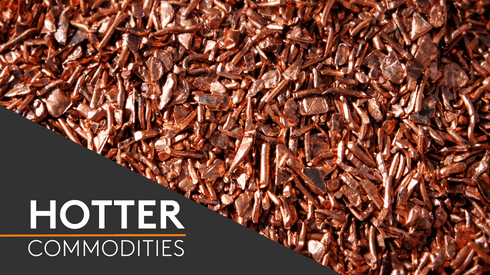Although they have increased, copper prices have risen less in recent months than many other commodities. The copper market has generally been less impacted by the war in Ukraine than other metals, such as aluminium, nickel and palladium.
“There are several reasons for this,” Edward Meir, head of research for ED&F Man Capital Markets, said, including that copper is not really in very short supply and its production is not concentrated in problem areas. Also, another market observer pointed out that copper is less energy-intensive to produce than is the case for certain other metals, so it has not been as impacted by the surge in energy prices that has been one of the main international consequences of the war.
Despite this, Andrew Cole, Fastmarkets principal metals and mining analyst, said that he expects the global refined copper market will be in a supply deficit this year, as it was in 2021, although he is forecasting that the deficit will narrow slightly this year to about 411,000 tonnes from last year’s deficit, which the latest International Copper Study Group (ICSG) forecast sets at about 475,000 tonnes.
As that is still a large supply-demand imbalance, Cole said that, at least based on market fundamentals, that should support higher copper prices. “But there is more in play than just market fundamentals,” he pointed out, including all the macroeconomic and geopolitical uncertainties. “That will translate into plentiful price volatility,” he said.
That volatility is likely to continue not just in the near term, but probably through the medium-term, according to Geordie Wilkes, head of research at Sucden Financial, given that, even if peace talks succeed, the sanctions that have been imposed upon Russia are not going to be released immediately, “And that could even cloud the longer-term outlook.”
Meanwhile, he noted that with growing inflation in most regions of the world, central banks, who were initially slow to react, are now tightening their monetary policies. He said that these higher costs, particularly higher energy costs, is affecting consumer demand for goods and services, and therefore copper demand.
John Mothersole, a director of S&P Global’s market intelligence unit, said this, as well as a recent revival in global copper mining capacity, is supportive of a consensus that started to build late last year that the copper market is about to transition, at least for the next few years, from deficit to surplus. He said that will still likely be the case even with the war in Ukraine disrupting some supply chains globally, and with Russian products, including copper, being rejected in many parts of the world – although not necessarily by China or India. “And even if companies are willing to accept Russian material, they might find it difficult to find a financial institution to underwrite the transaction,” he added.
With the market moving into surplus, Michael Haigh, head of commodity research for Société Générale, said that copper prices will likely move downwards from about $10,300 per tonne at the end of March to $9,000 a tonne, or even slightly lower, by the end of the year, hovering at that level until 2024, at which time it could even briefly fall below $8,000 per tonne before starting to move back up again in 2025.
A green transition
Colin Bennett, market intelligence director for the International Copper Association (ICA), said that given all the green drivers in the marketplace – including the push for electrification, growing use of such sources of renewable power as wind and solar and the increased need to improve energy efficiency, there should be continued, albeit largely incremental (a few percentage points per year) growth in demand for such copper products. “While in these uncertain times people have generally been holding back from making any big forecasts or claims, it is clear that the energy transition, while being a long-term game, is under way.
It will have positive implications for copper. In fact, Vivek Tulpule, head of economics and markets for Rio Tinto, said that over a quarter of copper consumption in 2050 will be attributable to the additional demand associated to the transition to net zero emissions.
Christian Georges, Société Générale’s head of metal and mining research, said that electric vehicles (EVs) generally have four times the amount of copper as internal combustion engine (ICE) vehicles. “Also, as demand for EVs increase, so will the demand for electricity and for the production of microchips,” he said, all of which could lead governments to push for more copper production in certain areas.
Another reason why the copper market is not seeing as much volatility as some other metals is because copper demand in China, which accounts for about 50% globally, seems to be slowing, Meir said, pointing out that a change from 10% to 2% economic growth per year is a huge swing, and one that results in about a million tonnes of copper being held back, especially given that China’s real estate market, which accounts for about 9% of global copper consumption, is struggling very badly.
Meir noted that this comes as Chinese real estate developers have become overleveraged in wealth management products and that now, with property prices falling for five of the past six months, people are not as infatuated with real estate in China as they once were. He said that this real estate shock is expected to reverberate down the value chain, with copper being one of the commodities that will be impacted.
Meanwhile, recent lockdowns, which are part of China’s zero-tolerance Covid pandemic policy, could have a negative impact upon the copper market as they could affect the production of copper-containing goods. Georges noted, however, that at the same time the Chinese government has been providing certain incentives aimed at boosting the nation’s purchasing managers’ index (PMI) growth rate and energy infrastructure. “Their build-up of such alternative energy generation as wind and solar farms also requires the building of transmission lines to transport that energy, and most of those cables tend to be made from copper,” Georges said.
Overall, Cole said that Fastmarkets is forecasting that Chinese apparent copper demand will be up by about 5.2% in 2022, following a flat year in 2021 when the stocks that were built up in 2020 were worked down. But Wilkes noted that the Chinese manufacturing PMI is currently only 50.2%, which is barely expansionary, and its GDP growth is expected to soften from its fourth-quarter rate of 4%.
Mixed international picture
Outside China copper demand is mixed, largely based on the regional macroeconomic situation. While Fastmarkets is forecasting US copper demand to grow by about 7% in 2022, Cole said that in Europe – being hit hardest by the consequences of the war in Ukraine – copper demand could contract by 2-3% with high energy costs being a major negative factor for Europe, given its dependency on Russian oil and gas.
Mothersole said that the war in Ukraine dominates everything in Europe, noting that last year European copper consumption was up by 7-8% in 2021, but now with Russia’s invasion of Ukraine, he is expecting European GDP growth to only be about 2.4% in contrast with expectations for 3.1% GDP growth prior to the war.
Much of that impact, according to Wilkes, is the effect that inflation has had upon European consumer confidence and therefore purchases of certain products. He said that that even with the push for more EVs, European auto registrations are down, given the combination of higher vehicle prices and the continued shortage of semiconductor microchips. He said that European construction activity has also been easing and that all these factors will likely filter down to lower demand for copper wire and cable, not just in Europe but across the globe.
Carlos Risopatron, ICSG’s director of economics and environment, pointed out that even before the war energy costs were already negatively impacting the European market. While some of these trends are also affecting the US, its copper demand growth has, at least to date, been more resilient. But while currently US manufacturing activity is strong, with more growth than in Europe or in China, the Institute for Supply Management’s manufacturing PMI, while staying well into positive territory at 57.1%, eased slightly month on month in March, and while US housing starts moved up in February new permits slipped.
Globally this year there seems to be less interest in substituting aluminium for copper, with ICSG’s Risopatron attributing that not only to the increase in aluminium prices due to the war in Ukraine, but rising energy prices over the past six months. This, according to ICA’s Bennett, is a reversal from last year when the global substitution rate increased to 1.32% from 0.95% in 2020. “Copper prices are still higher than aluminium prices,” Mothersole pointed out, “But the current differential isn’t wide enough to stimulate substitution.”
Supply growth
Meanwhile, the outlook for the supply side of the equation is cloudy. “There are quite a lot of mine projects that could potentially be expanded,” Bennett observed. “But because of certain regulatory issues there has been some hesitation in the mining industry, which has been preventing some of those expansions from going ahead.
One example of this is Antofagasta’s Twin Metals copper and nickel mining project in Minnesota, which, reversing an earlier decision, had two mineral leases canceled by the US Department of the Interior on environmental grounds in late January.
Nevertheless, there is optimism about certain other projects, Mothersole said. For example, the Anglo American Quellaveco Mine in Peru, as well as the Taseko Florence Mine in Arizona – a new greenfield mine in the US – are expected to have their final permitting approved. Underground operations are now under way at the Oyu Tolgoi copper/gold project in Mongolia, which, according to Jakob Stausholm, Rio Tinto’s chief executive officer, is expected to produce about 500,000 tonnes of copper per year starting in 2028.
“Not only has the amount of red tape to get new mine projects been increasing,” Société Générale’s Georges pointed out, but the grade of copper at such new mines have been decreasing. Nevertheless, he expects that new copper mine capacity will increase by about 7% over the next two to three years. “But given the expense of doing so, companies are being very cautious about launching new projects.”
On the plus side, Cole pointed out that lately mine disruptions have not generally been as severe as they had been in previous years and in many cases new mine projects, such as the Kamoa-Kakula project in the DRC, have been ramping up impressively. Wilkes also pointed out that the Grasberg Mine in Indonesia and Chuquicamata Mine in Chile should be stepping up their production this year. Cole said all of this is contributing to the copper market’s transition from deficit to surplus and is behind a higher benchmark TC/RC in 2022 and the rising spot TC/RCs so far this year.
The rate of mine production increases, however, has varied – not just by region, but also by country. Mothersole noted that while Peruvian mine production has been up nicely since the beginning of 2022, that has not been the case in Chile, where it has at least temporarily sputtered out early this year, despite the recovery that had been seen in the second half of 2021. He said, however, it is likely that it will improve again late this year or early in 2023, which he said will be a contributing factor to copper’s expected transition into surplus.
However, one concern will be the decline in resources and in ore grades, Mothersole noted, although he is hopeful that improvements in mining technologies could more than compensate for that.
The cost of investing in new capacity is another factor, Risopatron said, observing that while prices would seem to be high enough to encourage miners to step up their production, “But their costs are also going up.”
| Global refined copper supply-demand balance (‘000 tonnes) | ||
| Year 2021 | Year 2022f | |
| China | 10,637 | 11,136 |
| Americas | 4,419 | 4,607 |
| Europe | 3,743 | 4,015 |
| Others | 6,240 | 6,570 |
| Production | 25,039 | 26,328 |
| % change y-on-y | 2.2% | 5.1% |
| China | 14,457 | 15,202 |
| USA | 1,817 | 1,944 |
| EU | 2,900 | 2,817 |
| Others | 6,461 | 6,775 |
| Consumption | 25,635 | 26,739 |
| % change y-on-y | 2.6% | 4.3% |
| Balance | -596 | -411 |
| % of consumption | 2.3% | 1.5% |
| Reported stocks | 1308 | 897 |
| Week’s use (reported) | 2.7 | 1.7 |
| Source: ICSG, Fastmarkets | ||
Meanwhile, Cole pointed out that another factor is Russian copper supply, although he said it is likely that supply will be redistributed from the West to China, rather than being totally lost, therefore not really affecting the global supply-demand balance.
Meir noted that the reluctance for companies in the West to buy Russian copper is exacerbated by the issues they would face with financing, shipping, warehousing and insuring Russian metal. He said the question is whether all the 800,000 tonnes per year of Russian copper – which is about 4% of the global copper supply – will be able to be redistributed, or only about half of that, which, if that were the case, could result in about a 600,000-tonne overall deficit. He added that while that would be a substantial deficit, it is not enough to drive copper prices much higher, as there would be enough supply from both the refined and scrap side to cool off such a rally.
At the same time, much as for most base metals, copper inventories are low at present. Surprisingly that has not lifted copper prices as much as might be expected, Haigh said – perhaps because the market is expecting the short-term supply situation to come to the rescue.
“It has been a challenging market so far this year and it will likely remain challenging, if for no other reason than because of all the moving parts and economic and political uncertainties,” Mothersole said.






